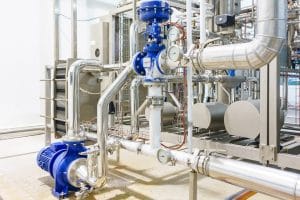 The greatest advantage of today’s advanced heat exchangers is that they can be designed to address virtually every type of thermal management need for nearly any type of application. For example, cold plates are a specific type of heat exchanger that are frequently utilized for high-performance applications that require efficient heat transfer across varying spaces. The fluid inside of a cold plate heat exchanger flows through pathways that are custom-machined into them, which allows for maximum heat transfer capabilities within limited spaces.
The greatest advantage of today’s advanced heat exchangers is that they can be designed to address virtually every type of thermal management need for nearly any type of application. For example, cold plates are a specific type of heat exchanger that are frequently utilized for high-performance applications that require efficient heat transfer across varying spaces. The fluid inside of a cold plate heat exchanger flows through pathways that are custom-machined into them, which allows for maximum heat transfer capabilities within limited spaces.
A Look at Cold Plates
The goal of modern thermal management solutions is to continuously transfer and control large amounts of waste heat, typically to prevent electrical enclosures and components from overheating. Depending on the size of the application, cold plates may be the optimal solution for such applications because they can minimize the amount of space needed to effectively cool more sizable equipment. However, cold plates can also be utilized for applications such as computer processors and other smaller, more powerful technologies, especially because the plates can be stacked to maximize the amount of heat that the solution can handle.
Making the Most of Modern Heat Transfer
Because of their ability to pack high-performance thermal management into limited spaces, cold plates (along with other types of heat exchangers) are popular for a wide variety of needs throughout various industries. For instance, food and beverage companies often implement cold plate heat exchangers for applications such as pasteurization and storing perishables at consistent temperatures. In many cases, cold plates can be combined with other heat exchanger solutions to provide optimal thermal management across several different industrial processes.
To learn more about advanced thermal management with cold plate heat exchangers, call Noren Thermal Solutions in Taylor, TX, at 866-936-6736.







